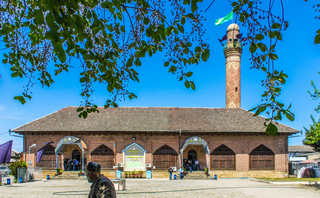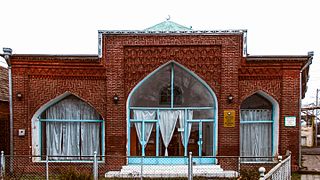
Ganja is Azerbaijan's third largest city, with a population of around 335,600. The city has been a historic and cultural center throughout most of its existence. It was the capital of the Ganja Khanate until 1804; after Qajar Iran ceded it to the Russian Empire following the Treaty of Gulistan in 1813, it became part of the administrative divisions of the Georgia Governorate, Georgia-Imeretia Governorate, Tiflis Governorate, and Elizavetpol Governorate. Following the dissolution of the Russian Empire and the Transcaucasian Democratic Federative Republic, it became a part of the Azerbaijan Democratic Republic, followed by Azerbaijan SSR, and, since 1991, the Republic of Azerbaijan.

Sheikh Ibrahim mosque (Azerbaijani: Şeyx İbrahim məscidi is a historical mosque of the XV century. It is a part of Old City and located on A.Zeynalli street, in the city of Baku, in Azerbaijan.
Musa bey Rafiyev Haji Mammadhuseyn oglu, also known as Musa bey Rafibeyli, was an Azerbaijani public, political, and state figure. He was a member of the Muslim faction of the Transcaucasian Sejm and the Azerbaijani National Council. He held ministerial positions in the second and fifth governments of the Azerbaijan Republic. Elected to the Azerbaijan Republic Parliament from the Musavat party, he served on the Finance and Budget Commission.

Chokak Hamam is a historical bath near Juma Mosque in Ganja. Historical-architectural monument built in 1606, by order of Shah Abbas.

Haji Shahla Mosque Hacı Shahla Mosque is an architectural monument dating back to the 14th century located in the Balakhany town of Baku. The inscription on the mosque indicates that it was built in 1385-1386 by the order of Hacı Shahla bin Shakir bin Mustafa Köşkin and constructed by the master architect Arif, son of the master Musa Jibal.

The Boyuk Bazar Mosque is a mosque in the city of Lankaran, Azerbaijan. The mosque was built in 1864 in the Boyuk Bazar neighborhood.

The Kichik Bazar Mosque is a mosque and historical architectural monument located in the center of the Lankaran district of Azerbaijan. The mosque was built in 1904.

The Haji Sultanali Mosque is a historical-architectural monument dating back to the early 20th century, located in Baku, Azerbaijan.

The Ozan Mosque -(Azerbaijani Ozan məscidi ) a mosque and historical-architectural monument built in 1884, located in the city of Ganja, Azerbaijan.

The Huseynia Mosque or the Tat Mosque is a historical and architectural monument of the 19th century located in the city of Ganja, Azerbaijan.

The Galagayin Mosque is a mosque in Qalaqayın, Sabirabad District, Azerbaijan.

Sakinakhanim mosque is a historical architectural monument built in 1854 in the city of Guba, Azerbaijan.

Chalabilar Mosque is a local significant historical and architectural monument dating back to the 17th century, located in the village of Çələbilər in Jabrayil district.

Ismail Khan Ziyadkhanov or Ismail Khan Ziyadkhanly was a member of the government of the Azerbaijan Democratic Republic, a diplomat, and a lieutenant colonel in the army of the Azerbaijan Democratic Republic. He was one of the five Azerbaijanis elected to the First State Duma of the Russian Empire.

Haji Badal Mosque- A historical and architectural monument from the 19th century, a mosque. It is located in the "Basqal" State Historical-Cultural Reserve in Azerbaijan.

Juma Mosque, also known as the Minaret Mosque, is a mosque and historical-architectural monument located in the city of Balakən, Azerbaijan. The construction of the mosque lasted 10 years and was completed in 1877.

Gulluk Mosque also known as the Gulluk Juma Mosque, is a historical-architectural monument dating back to 1727. It is located in the village of Gulluk in the Qakh district of Azerbaijan.

Juma Mosque (Qabala) is a historical-architectural monument from the 19th–20th centuries, located in the city of Qabala, Azerbaijan.
Sabiskar cemetery is a historical cemetery located in the city of Ganja, Azerbaijan. The cemetery contains 18 historical mausoleums. In addition, many prominent Azerbaijani figures are buried here. The Asgar Agha Gorani Mausoleum, located within the cemetery, is recognized as a local architectural monument.

Gizilhajili Mosque — a mosque and historical-architectural monument built in 1877, located in the city of Ganja, Azerbaijan.


















